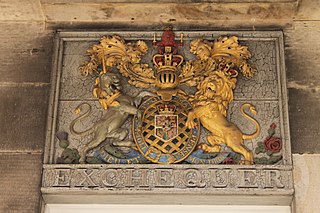
Earl of Stair is a title in the Peerage of Scotland. It was created in 1703 for the lawyer and statesman John Dalrymple, 2nd Viscount of Stair.

James Dalrymple, 1st Viscount Stair, Scottish lawyer and statesman, was born at Drummurchie, Barr, Ayrshire.

Sir David Dalrymple, Lord Hailes, 3rd Baronet of Hailes was a Scottish advocate, judge and historian, born in Edinburgh.

The Treaty of Union is the name usually now given to the agreement which led to the creation of the new state of Great Britain, stating that England and Scotland were to be "United into One Kingdom by the Name of Great Britain". At the time it was more often referred to as the Articles of Union.

Thomas Hamilton, 6th Earl of Haddington KT FRCPE was a Scottish politician and nobleman.

Sir Hew Dalrymple, Lord North Berwick (1652–1737) was a Scottish judge and politician.
The baronetcy of Cuninghame of Corsehill was created in the Baronetage of Nova Scotia and conferred upon Alexander Cuninghame of Corsehill, a Scottish baron and landowner in Dumfriesshire and a great-great-great-grandson of the 4th Earl of Glencairn. The fourth baronet's father added the name Montgomery before his own on inheriting the estate of Kirktonholm.

Hailes Castle is a mainly 14th century castle about a mile and a half south-west of East Linton, East Lothian, Scotland. This castle, which has a fine riverside setting, belonged to the Hepburn family during the most important centuries of its existence. Since 1926, it has been the subject of a state-sponsored guardianship agreement, which is now under the auspices of Historic Environment Scotland as a scheduled monument.
Robert Burnet, Lord Crimond was a Scottish advocate and judge.

Adam Cockburn, Laird of Ormiston, Lord Ormiston, was a Scottish administrator, politician and judge. He served as Commissioner for Haddington Constabulary in the parliaments of 1681-2 and 1689, and in the conventions of 1678 and 1689. He was appointed Lord Justice Clerk on 28 November 1692.

Clan Makgill is a Lowland Scottish clan.

The Scottish Exchequer had a similar role of auditing and deciding on Royal revenues as in England. It was not until 1584 that it also became a court of law, separate from the King's Privy Council. Even then, the judicial and administrative roles never became completely separated into two bodies, as with the English Exchequer. The Auditor of the Exchequer played a pivotal role in this important office of state.

Sir Charles Dalrymple, 1st Baronet, was a Scottish Conservative politician.
Chambers is a reference publisher formerly based in Edinburgh, Scotland, which held the property rights of W. R. Chambers Publishers.

Jemima Wedderburn Blackburn was a Scottish painter whose work illustrated rural life in 19th-century Scotland. One of the most popular illustrators in Victorian Britain, she illustrated 27 books. Her greatest ornithological achievement was the second edition of her Birds from Nature (1868). Most of the illustrations were watercolors, with early paintings often including some ink work. A few were collages, in which she cut out a bird's outline and transferred it to a different background, in a similar manner to John James Audubon. Her many watercolours showed daily family life in the late 19th-century Scottish Highlands as well as fantasy scenes from children's fables. She achieved widespread recognition under the initials JB or her married name Mrs Hugh Blackburn.

Sir James Dalrymple, 2nd Baronet was Member of Parliament (MP) for Haddington Burghs and the Principal Auditor of the Exchequer in Scotland.
Sir Charles Dalrymple Fergusson, 5th Baronet of Kilkerran FRSE (1800–1849) was a Scottish lawyer.

Newhailes House is a Palladian style country house which stands in 80 acres of parkland on the edge of the small town of Musselburgh in East Lothian, Scotland. Originally named Whitehills, it is a Category A listed building which is now occupied and maintained by the National Trust for Scotland.
Elizabeth Bruce was a daughter of King Robert the Bruce and was married to Sir Walter Oliphant (Olifaunt) of Aberdalgie and Dupplin.













